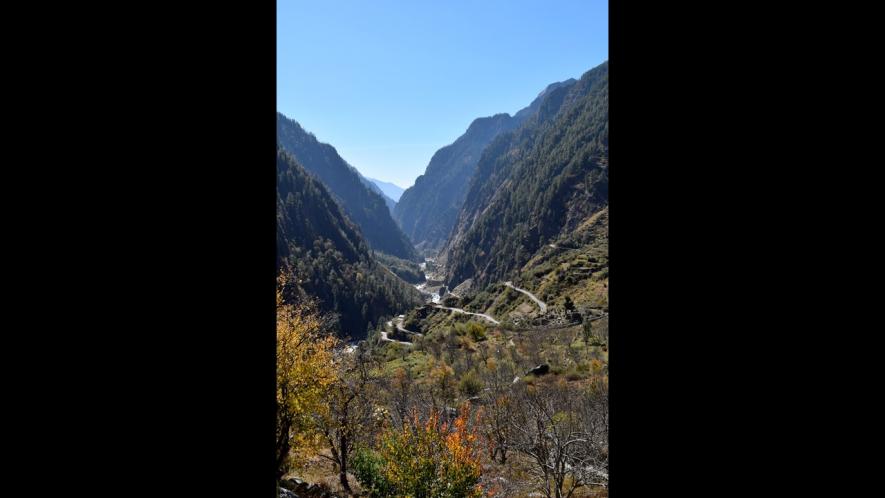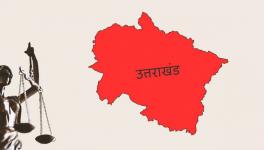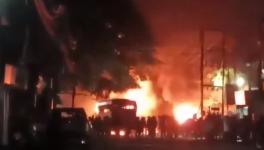‘Passed Without our Consent or Scrutiny’: Environment Experts Slam Bhagirathi Zonal Master Plan

The contentious Zonal Master Plan (ZMP) of the Bhagirathi Eco-Sensitive Zone (BESZ) was approved by the Ministry of Environment, Forests and Climate Change (MoEFCC) last month. However, members of two expert committees – one appointed by NGT or another by Supreme Court. – have said the document neither has their consent, not could they scrutinise it.
On July 17, Union Environment Minister Prakash Javadekar announced the ZMP’s approval, saying it would help expedite the Char Dham road project in Uttarakhand. Of the total 889 kilometres, a large part of the 160-km road stretch where work is yet to be undertaken lies in the BESZ and was pending due to the ZMP.
Members of two expert panels – the first committee constituted by the National Green Tribunal (NGT) and a scrutiny committee formed by the Supreme Court – wrote a joint letter to the MoEFCC and the Ministry of Water Resources (MoWR) that the approved ZMP did not have their consent nor approval. They added that they had not scrutinised it either. They expressed deep regret, saying that the current ZMP is a flawed document which is not in consonance with the ESZ notification.
“The present version of ZMP packages project reports prepared by various departments and emphasises on modifying the Eco Sensitive Zone (ESZ) Notification rather than realizing the spirit of the same,” Vinod Tare, a Professor at IIT Kanpur and a member of both committees, said in the letter.
The approved ZMP has been uploaded to the MoEFCC’s website.
On December 18, 2012, the Centre had notified a watershed area of near the river Bhagirathi, from Gaumukh to Uttarkashi covering an area of about 4179.59 square kilometres. It spanned 88 villages and was declared an Eco-Sensitive Zone; thereby prohibiting, regulating or permitting certain categories of activities in the said zone.
The ministry (Environment Ministry) had asked the state government to prepare a ZMP for the sustainable development and protection of this fragile zone based on its notification by 2014.
The ZMP was aimed at the conservation of existing water bodies, forests, for watershed management, soil and moisture conservation and the requirements of the local community through sustainable development strategies.
The notification clarified that there will not be any changes in land-use, hydro-power projects above 2 MW and prohibition on river-bed mining for commercial purposes in the region.
A state monitoring committee comprising state government officials and four NGO activists was also formed to ensure the compliance of guidelines under the notification, till such time as the ZMP comes into force. “The committee, which was entrusted with such an important task, was rendered toothless by the state government. It was to meet at least once every quarter, which was not followed,” said Mallika Bhanot, a member of the monitoring committee.
The ZMP, submitted by the state government in 2016, after a delay of two years, was rejected by the MoEFCC as well as the water ministry for not following the notification guidelines for the conservation of the region. For instance, the ZMP had hydro-power projects upto 25 MW, while as per the notification, only projects up to 2 MW were permitted.
In 2017, after a petition was filed by Uttarkashi-based activist Keshar Singh Panwar against the ZMP submitted, the NGT constituted a nine-member committee. The committee was made up of geologists, hydrologists, and environmental experts – they were given the mandate to prepare a fresh ZMP.
Since the head of the committee was government representative – an additional secretary – the other members moved the NGT, appealing for an independent person. However, their appeal was rebuffed by the NGT.
A new appeal was filed in the SC to replace the head of the committee. In July 2018, the SC issued orders for an investigation in the matter. Meanwhile, the head of the NGT committee prepared the ZMP, without the consent of the remaining eight members.
The apex court then asked the MoWR to scrutinise this ZMP via 11 members suggested by it in July 2018. However, before the MoWR could form a committee with those members, the state government submitted the same ZMP – without scrutiny – to the MoEFCC. Members of the scrutiny committee called it a violation of the SC order and of misleading MoEFCC.
The scrutiny committee, which was constituted in October 2018, also included members of the NGT committee, like environmentalists Ravi Chopra and Chandi Prasad Bhatt, Academician Vinod Tare and Wildlife Institute of India scientist S. Sathya Kumar. However, the MoWR did not call for a single meeting of this scrutiny committee.
“No meetings of both the expert panels – NGT committee and Scrutiny committee – were held by the state government or MoWR after July 2018. We were asked to mail our comments on the ZMP recently, and after a few days we got to know of the submission of the final draft of the ZMP,” Tare told News Click.
Comments of the members have been highlighted in the annexures to the ZMP published on the environment ministry’s website. The scrutiny group members also wrote to the MoWR, saying that it was the old draft ZMP – essentially a compilation of departmental proposals mainly based on current schemes – and therefore cannot be accepted. This should be a people’s plan not a departmental one, they said, alleging that no public consultation, especially with women (which the notification stipulated) was held to prepare the ZMP.
“The draft ZMP still remains largely faithful to the rejected ZMP of October 2016. It lacks an integrated approach, as desired by the Union Ministries. Based on the foregoing it is not possible to accept the present ZMP draft,” Ravi Chopra submitted in his letter.
Hemant Dhyani, another member, also pointed out in the letter that the NGT committee members have received representations from the 16 village panchayats of Uttarkashi, that their villages have been merged with Nagar Palika without any public consultation. This is also in violation of the BESZ notification.
“The state government did not have the authority to submit the draft. The NGT had mandated a nine-member committee to prepare a fresh ZMP to be submitted to MoEFCC, a copy of which was to be given to the NGT,” a committee member told NewsClick.
Budging before the objections of three chief ministers and the local politicians of Uttarkashi, for being anti-development, the notification was amended on April 16, 2018.
It approved land use change to meet local needs and infrastructure development in view of larger public interest and national security, with the condition of seeking prior approval of the state government after due study of environmental impact.
Slope cutting for construction purposes was also permitted, but after a proper study for the benefit of the community.
NGT committee members had opposed slope cutting saying it leads to landslides, soil erosion and that it generates debris. They said that projects like road widening would result in the loss of forest cover and precious Deodar trees.
The writer is a freelance journalist who writes on the environment.
Get the latest reports & analysis with people's perspective on Protests, movements & deep analytical videos, discussions of the current affairs in your Telegram app. Subscribe to NewsClick's Telegram channel & get Real-Time updates on stories, as they get published on our website.























